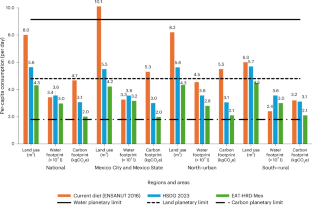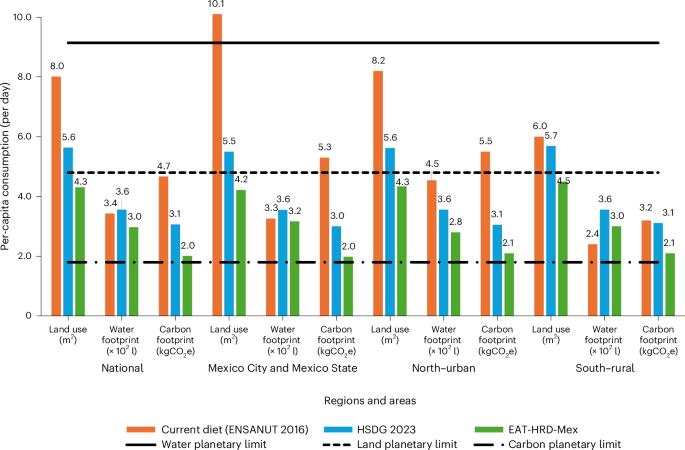Mexican national dietary guidelines promote less costly and environmentally sustainable diets
IF 23.6
Q1 FOOD SCIENCE & TECHNOLOGY
引用次数: 0
Abstract
The 2023 Mexican Healthy and Sustainable Dietary Guidelines (HSDG 2023) were developed to include all dimensions of sustainability. Here we compare the environmental impact and cost of diets based on the HSDG 2023, current diets and the Mexican-adapted EAT healthy reference diet. Diets following HSDG 2023 are 21% less expensive, require 30% less land to be produced and have 34% less carbon emissions than current diets—particularly in Mexico City and other urban areas with higher prevalence of Westernized diets. This is driven by reduced animal-source food, especially red meat, and ultra-processed foods. In south–rural areas, the water footprint and cost of diets following HSDG 2023 were higher than those of current diets owing to increased intake of nuts, fruits and vegetables not offset by lower meat consumption (which is already close to recommendations). Diet environmental impact and cost could be further reduced with the Mexican-adapted EAT healthy reference diet compared with the HSDG 2023. Sustainability is increasingly integrated into national food-based dietary guidelines, but how and to what effect requires investigation. This study analyses the costs and environmental impact of the 2023 Mexican Healthy and Sustainable Dietary Guidelines (HSDG) relative to current diets and the Mexican-adapted EAT healthy reference diet.


墨西哥国家膳食指南提倡成本较低且环境可持续的饮食习惯
2023 年墨西哥健康和可持续膳食指南(HSDG 2023)的制定包含了可持续发展的所有方面。在此,我们比较了基于《2023 年墨西哥健康与可持续膳食指南》的膳食、当前膳食和墨西哥适应性 EAT 健康参考膳食对环境的影响和成本。与目前的膳食相比,采用 HSDG 2023 的膳食成本降低了 21%,生产所需的土地减少了 30%,碳排放量减少了 34%,尤其是在墨西哥城和其他西化膳食流行率较高的城市地区。这主要得益于动物源性食品(尤其是红肉)和超加工食品的减少。在南部农村地区,由于坚果、水果和蔬菜摄入量的增加并没有被肉类摄入量的减少所抵消(肉类摄入量已经接近建议摄入量),因此采用 HSDG 2023 的膳食的水足迹和成本高于当前的膳食。与 HSDG 2023 相比,采用适应墨西哥的 EAT 健康参考膳食可进一步降低膳食对环境的影响和成本。
本文章由计算机程序翻译,如有差异,请以英文原文为准。
求助全文
约1分钟内获得全文
求助全文

 求助内容:
求助内容: 应助结果提醒方式:
应助结果提醒方式:


